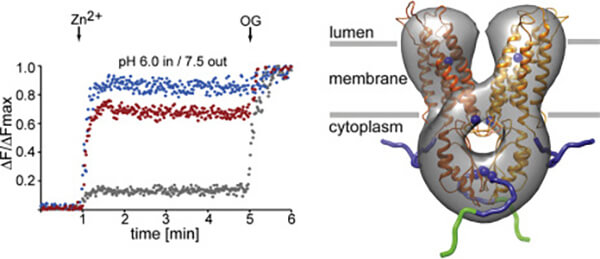Anti-SLC30A8 (aa 268-359) monoclonal antibody, clone 926140
Mouse Anti-Human ZnT-8 (aa 268-359) monoclonal antibody for IHC, ELISA
| Product Name | Cat. No. | Applications | Host Species | Datasheet | Price | Add to Basket |
|---|
As an indispensable trace element for the body, zinc plays a role in structural stability, catalysis and regulation in biological cells. It is an important component of more than 300 enzymes and transcription factors in the human body, and is directly involved in the synthesis of nucleic acids and proteins, cell differentiation and proliferation and many other important metabolic processes. Therefore, the steady-state balance of zinc ion metabolism is very important for maintaining normal physiological functions of the body. Zinc ions cannot pass through the cell membrane freely and need to be transported and metabolized through specific transporters and membrane channels. Among the family of proteins that maintain zinc homeostasis, zinc transporters are crucial. Zinc transporter 1-10 (ZnT1-10) is a member of the cation diffusion facilitator (CDF) family of metal ion carriers. Its role is to transport zinc out of cells or into organelles. ZnT8 (zinc transporter 8, encoded by the SLC30A8 gene) is a member of the zinc transporter family. It was originally discovered in pancreatic islet β cells and is related to the synthesis, storage, and release of insulin. In β-cell-specific SLC30A8-deficient (ZnT8KO) mice, although the islet β-cells of ZnT8KO mice secrete too much insulin, their peripheral blood insulin levels are relatively low, which illustrates the functional relationship between SLC30A8 deficiency and hepatic insulin clearance. Therefore, SLC30A8 can regulate hepatic insulin clearance. Reduced ZnT8 protein activity, DNA variation, and SLC30A8 gene methylation changes may play a certain role in the occurrence and development of diabetes.
 Figure 1. Structure Analysis of human ZnT8 (SLC30A8). (Source: Daniels MJ, et al. 2020)
Figure 1. Structure Analysis of human ZnT8 (SLC30A8). (Source: Daniels MJ, et al. 2020)
The SLC30A8 gene is located on chromosome 8q24.11. The encoded protein consists of 369 amino acids and has a molecular weight of 40755 Da. The SLC30A8 gene consists of 8 exons. The study found that two common single nucleotide polymorphisms (SNPs) related to susceptibility to diabetes in the SLC30A8 gene are rs13266634C/T (R325W) and rs11558471A/G. Both SNPs are located in exon 8. SNPrs13266634 is non-synonymous, which causes the single amino acid encoding 325 to change from R (arginine, CGG) to W (tryptophan, TGG), reducing the activity of the zinc transporter, thereby reducing intragranular zinc levels. The amino acid of SLC30A8 gene is located in the C-terminal part, which is a topological domain encoding protein. SNPrs11558471 is synonymous and located in the 3′ untranslated region. There is also a CpG island in the gene promoter region of the SLC30A8 gene, containing 6 CpG sites, including the transcription factors PPAR1 and 2.
During the development of T1D, the emergence of cellular and humoral autoimmunity marks the body's production of autoantibodies against beta cells. Islet cell autoantibodies (ICA) were the first autoantibodies found to be related to T1D. Since then, other antibodies such as insulin (IAA), glutamic acid decarboxylase (GAA or GAD) and protein tyrosine phosphatase (IA2 or ICA512) have also been found to be related to T1D. The number of antibodies is often more important in predicting the progression of overt diabetes. In recent years, approximately 26% of T1D subjects have been found to be positive for SLC30A8 autoantibodies, and approximately 60% of new cases of T1D patients have been found to be positive for SLC30A8 autoantibodies before developing clinical symptoms, so SLC30A8 is considered a new autoimmune targets of T1D. SLC30A8 has emerged as an additional, independent predictive marker for T1D. Studies have shown that the C/C genotype of SLC30A8 may be related to the genetic susceptibility to T1D. The heritability of type 2 diabetes (T2D) is 31% to 69%. It has an obvious genetic tendency and is a complex polygenic genetic disease. Researchers used a genome-wide association study (GWAS) method to discover for the first time a correlation between the SLC30A8 gene and type 2 diabetes in the French population. In Asian populations, allele A of rs11558471 has been found to be associated with T2D, which suggests that this gene may be a susceptibility gene for T2D, and the loss of SLC30A8 function may have a protective effect against the disease.
Solute Carrier Family 30 Member 8
Zinc transporter 8
Zinc transporter-8
References
1. Daniels MJ, et al. Structure/Function Analysis of human ZnT8 (SLC30A8): A Diabetes Risk Factor and Zinc Transporter. Curr Res Struct Biol. 2020, 2:144-155.
SLC30A8 mutations in type 2 diabetes
Diabetologia
Authors: Rutter GA, Chimienti F.
Genetic, Epigenetic and Biological Effects of Zinc Transporter (SLC30A8) in Type 1 and Type 2 Diabetes
Curr Diabetes Rev.
Authors: Gu HF.
Invoice / Purchase Order
Credit card
![]()

![Recombinant Human Zinc transporter 8 [His] (DAGC025)](http://img2.creative-diagnostics.com/productimages/DAGC025-1.png)